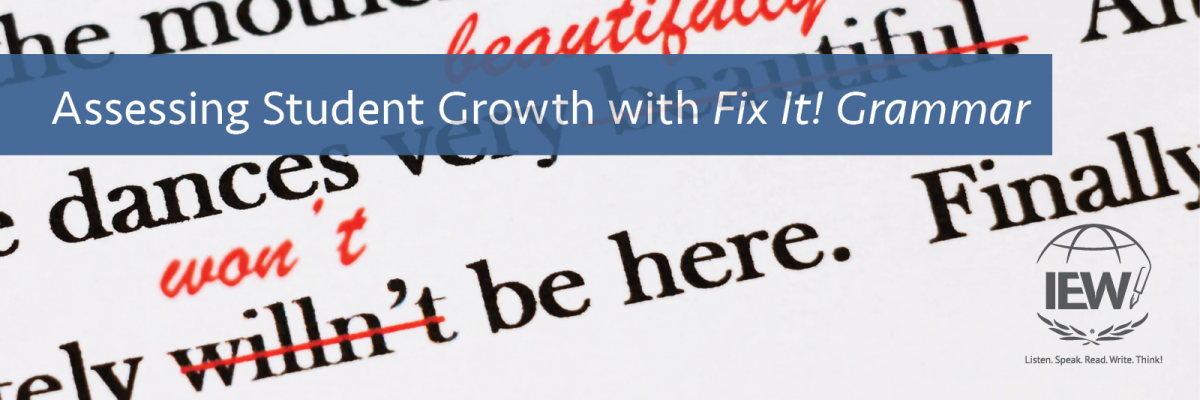
Teachers in school classrooms need opportunities for assessing student growth whether by traditional tests or by some other assessment. Educational assessments are methods of measuring students' learning and progress. They are essential tools for classroom teachers and students to monitor, evaluate, and improve learning. Thoughtfully using information gained from assessments, teachers can help guide and engage their students in mastering concepts. There are different types of assessments for different purposes and levels of cognition. To gauge student learning, understanding, and growth in the classroom, Fix It! Grammar passages can be used for three common types of assessments: diagnostic, formative, and summative. Although these assessments are not necessary in a homeschool setting, the passages in each level can be used for these types of assessments for students in a traditional school classroom where quizzes and tests are expected.
Diagnostic Assessments—Knowing if there is a learning gap
Diagnostic assessments provide valuable feedback for both teachers and students although they are not graded. They identify students' strengths and weaknesses before instruction. Used to determine the students’ prior knowledge and needs, these assessments help teachers plan their lessons while also providing students with insight into their own learning goals and gaps. Usually, teachers give these assessments at the beginning of the year before a new unit of study or upon a new student joining the class.
On the Fix It! Grammar webpage, find the sample lessons for the first four levels. Pick a sentence from week eighteen from the level you intend to use with your students and have them use the checklist at the top of the page to find and correct the errors in the passage. As you review the students’ papers, note areas of strength and diagnose areas to focus on during the learning to come for the class as a whole and for individual students. This process can also be used to determine if the level of Fix It! Grammar you have chosen is best suited for your students’ abilities. During the year you can use simple entry ticket or thumbs up/thumbs down activities to assess students’ knowledge of the new concept being introduced in the weekly Learn It! lesson.
Formative Assessments—Knowing what the student does not know
Monitoring students' learning and providing feedback during instruction, formative assessments help teachers adjust their teaching strategies and activities as needed. Given shortly after students are taught a new skill, formative assessments help students check their understanding and improve their skills. Formative assessments are not always graded, but they are essential for learning.
The checklist of items to mark and fix at the top of each Fix It! Grammar passage can be used for formative assessment. Giving a formative assessment is as easy as walking around the room and noting each student’s work. If you notice an area of concern for the group or for an individual student, ask students to point out certain fixes on their pages. Occasionally, have students turn in one of the passages from the week to review further and assign a quiz grade. Use the process to learn if students understand a new concept or if reteaching the lesson is needed. You can also identify individual students who need focused support.
Summative Assessments—Knowing what the student knows
Summative assessments are used to evaluate students' learning and achievements at the end of instruction. Generally, they are called tests. Teachers use them to measure the effectiveness of their teaching and the outcomes of their curriculum. They also help students demonstrate their mastery and ability to apply their knowledge. Although summative assessments are graded, they are not the only indicator of learning.
In a traditional classroom, teachers are often required to post regular assessment grades in their gradebooks. About every four to six weeks, use the weekly Fix It! Grammar lesson as a summative assessment. Instead of completing the daily passages, use class time to review the concepts learned in previous weeks. Both the scope and sequence at the beginning of the book and the Fix It! Grammar Glossary at the back of the Teacher’s Manual are handy resources for pointing students to information and examples about specific concepts. On test day have students fix all four days of passages in the weekly lesson and submit for grading. Possibly the best indicator of student mastery of a concept is the ability to use the concept correctly in their own writing. When using Fix It! Grammar in tandem with Structure and Style for Students or theme-based writing lessons, teachers know whether students understand the grammar taught in Fix It! by their ability to incorporate the concepts in their writing assignments.
Educational assessments are diverse and dynamic tools that can enhance the learning process for both teachers and students in a traditional classroom setting. Such assessments are not needed in homeschool or co-op situations where parents and teachers can easily recognize what their students understand. Teachers in a school classroom can provide meaningful feedback, guidance, and support for their students. With all three assessment types, take time to help students understand their strengths and learning gaps so they know where their knowledge has grown and where they need extra practice. This step makes students more aware, engaged, and empowered in their own learning journeys.
by Andrea Pewthers
